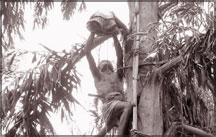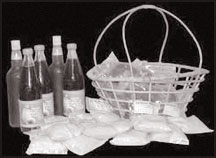Kithul
The wish - conferring tree:
by Madhavi Sandhyalekha Wijerathna
The sunrise brings another new day to the village. The villagers get
ready to harvest one of the most valuable products from mother nature.
Here is how they turn their thoughts into words:
"Waradak nathuwa bammak bandinawa dutimi
Ledak nathuwa bethak kawanawa dutimi
Dukak nathuwa kandulak watenawa dutimi
Kalayak aran jalayak banawa dutimi"
(I saw a bond bound without any need \I saw a medicine given without
any ill \I saw a tear shed without any sorrow \I saw an empty vessel
brought down full)

The kithul or fish tail palm is a popular tree among the rural
community in Sri Lanka. This tree is botanically known as Caryota urens
which belongs to the family Palmae. Traditionally the coconut tree,
Cocos nucifera which belongs to the same family Palmae is known as the
wish-conferring tree, ("Kapruka") since all parts of this tree have
important and different uses as a multipurpose tree.
All parts of the Kithul tree too have different and valuable uses.
Therefore, it is worthwhile to recognize this multipurpose palm as
another or second wish - conferring tree ("kapruka") for Sri Lankans.
Under favourable conditions, the Kitul tree may grow to a height of
40 - 50 feet and a girth of 4-6 feet. The girth of the lower part of
some Kitul trees is less than that of the middle part which is not
common among the other tree species.
These types of trees are known as female trees by the village
community. Kithul leaves are bipinnate and leaflets are broadly
toothened. A well-grown tree contains 10-20 leaves.
The rural people obtain a number of economically important products
from the Kitul palm.
|

Treacle and jaggery are the main products of the Kitul sap |
The flower is the most useful part of the tree. The Kithul flower is
tapped to obtain sap of the tree and that is the most important primary
product of a Kitul palm. In general a single tree yields 7-14 liters of
sap per day and the sap exudation continues to 3-4 months.
Tapping the flower for obtaining the sap is an art and technique that
has to be learnt. These techniques are inherited from generations to
generations as secrets through the centuries.
A bamboo tree is fixed to the trunk to reach the inflorescence.
Climbing the tree as well as the sap collection process is a risky and
trying job, which should be done carefully.It is needed to temper or
season the flower before its maturity to obtain the sap.
Objectives of seasoning are delaying maturity to extend longevity of
the sap flow, bending a flower downwards to facilitate the easy
collection of the sap and the tenderisation of the flower for easy
slicing.
In rural villages the tapping process of an inflorescence is started
on an auspicious day or a time. The number of pre-treatments involved in
seasoning a flower vary from location to location and person to person.
Basically the main treatments involved are: burning, piercing,
beating and treating with botanicals. The natural mixtures used in
seasoning may be Spice-based, Citrus-based, Medicine-leaves-based,
Pepper-based, or Ash based mixtures and some are non-specified.
Materials and equipment used for these processes as well as for the sap
collection are location specific.
Rural people in Sri Lanka respect the Kithul tree as they receive an
endowment from nature in the form of sap. Many rituals and beliefs are
connected with this tree and some of them have contributed for the
natural existence of this tree species without extinction.
One such practice is leaving the first flower of a tree without
tapping for the deities above which ensures the seeds for the birth of
the next generation.
Treacle and jaggery are the main products of the Kitul sap.
Unfermented sap is needed to make both these products. Therefore, the
sap collected should be boiled without delay before it gets fermented.
The tappers apply a light coat of slaked lime inside the sap
collecting pots to prevent microbial activities which cause fermentation
of the sap.
The collected sap is filtered to remove extraneous matter as the
first step of the treacle production process. Then it is boiled at a
moderate temperature until it reaches the proper concentration.
People who are engaged in this industry know the appropriate
concentration for treacle through experience. Finally, the produced
treacle is filled into cleaned bottles for marketing. The rest is stored
in clay pots in rural villages for their use as well as to be used in
the future. The unfermented Kithul sap is concentrated further to make
jaggery. Stirring is needed throughout the heating period.
After the correct concentration is reached, the stuff is decanted
into coconut shells to solidify and to get the formal shape of the
jaggery. In commercial production, a wooden frame is used for this
purpose to obtain a flat and squire shape which facilitates easy
packing, transport and storage.
Traditionally the Kitul jaggery is wrapped within dried banana
leaves. Presently polythene bags are used for this purpose. Sri Lankans
use jaggery with different herbal drinks and beverages like tea, and
coffee as a substitute for sugar.Kitul flour is another product of this
valuable palm.
The flour is in the pith of the trunk. In the extraction process of
flour, first a kithul tree is cut down. Then, the pieces of pith are
removed from the trunk. After that, the pith is cut into small pieces
and powdered using the mortar and pestle.
Next, a pot is filled with water and a clean cloth is tied to its
mouth. Then the crushed pith is mixed with water and allowed to strain
through the cloth to the pot. After sometime, the flour settles down in
the pot. It is sun dried to make Kithul flour. This flour can be kept
for a long time. The flour is used for different preparations. "Kithul
thalapa" is one such preparation.
The fermented sap of the Kitul tree is known as toddy, which contains
5.0-5.5 per cent of alcohol equal to the strength of beer. It is widely
used by the rural community in Sri Lanka as an alcoholic and energizing
drink.
Presently there is a high demand for Kitul-based products both
locally and internationally. Therefore, the Kitul industry is a good
income source for the rural people and to the country as a whole. With
the recent findings of scholars at the Industrial Technology Institute
that Kitul sap and its products have anti-diabetic properties, the
future demand for Kitul products would definitely increase.
The Kithul based products are popular as organic foods since the
primary product is obtained from naturally grown trees, which are free
from chemical residues. On the other hand, the Kitul tree and the Kitul
products have a high medicinal value. The roots and barks are medicinal
ingredients in native treatments. Native physicians prescribe Kitul
flour for gastric ulcers, hypertension and migraine headaches.
The mature Kitul trees are a source of valuable timber. It is hard
and durable. Therefore, the rural people use it especially to make
mammoty handles, walking sticks, motar and pestles, rafters and reapers.
It is widely used for many other purposes due to its strength,
durability as well as the availability. Furniture made out of Kitul
timber has a high market value due to its attractive black colour and
durability. Different handicrafts are produced using Kitul timber and
other parts of the tree as well.
Kithul trees especially the dwarf varities have an aesthetic value.
Therefore it is used to add beauty to the landscape. The leaves are used
for different decorations and floral arrangements. Therefore, the leaves
have become an exportable item. The long spikes of the Kithul flower is
also used for different decorations.
Kitul is a multipurpose tree but its potential has not yet been fully
exploited. By considering all these aspects the effective measures
should be taken by the relevant authorities to develop the Kitul
industry in Sri Lanka. |
